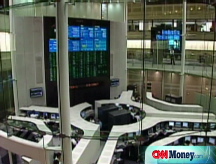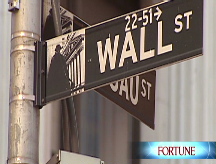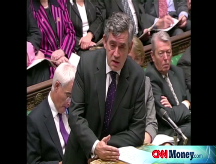Vertigo on Wall Street
Volatile Dow plunges as much as 697 points, rises as much as 322, as panicky investors try to find their footing.
 |
| The Dow traded in a 1,000 point range Friday for the 1st time in its history. |

NEW YORK (CNNMoney.com) -- Stocks ended with slim declines Friday, as investors fought back from a decline of as much as 697 points on the Dow amid the global market meltdown.
Credit markets remained tight, although short-term lending showed some improvement from recent days. Treasury prices fell, raising the corresponding yields. The dollar gained versus the yen and fell against the euro. Oil, gas and gold prices fell.
The Dow Jones industrial average (INDU) lost 128 points, or 1.5%, while the Standard & Poor's 500 (SPX) index lost 1.2%
The Nasdaq composite (COMP) ended 0.3% higher, following a seven session losing streak.
For the week, the Dow fell just over 1,874 points, or 18%, its worst weekly decline ever on both a point and percentage basis. Wall Street lost roughly $2.4 trillion in market value during the week, according to losses in the Dow Jones Wilshire 5000, the broadest measure of the market.
On Friday, finance ministers from the Group of Seven (G-7) nations said that exceptional steps are needed to ease the global financial crisis and get money flowing again.
In the first five minutes of trade Friday the Dow plunged 697 points, falling below 7,900 to the lowest point since March 17, 2003. The Nasdaq and S&P also hit more than five-year lows. But stocks recovered abruptly, with the Dow erasing losses. The afternoon saw the Dow make violent swings back and forth across the breakeven line, toppling as much as 600 points and rising 322 points.
The Dow has now tumbled for eight consecutive sessions, losing nearly 2,400 points, or 22%, as panicked investors ditched stocks across the board.
The panic gripped the global markets as well, with the Japanese Nikkei tumbling 9.6% Friday and the London FTSE down 8.9%. The global selloff kept the pressure on U.S. markets Friday.
"The magnitude of what's going on is unprecedented and people are frightened," said Robert Philips, senior portfolio strategist at BLB&B Advisors.
Stocks have plunged despite a series of efforts on the part of the government to unfreeze the credit markets and get money flowing through the system again.
"Fear is feeding upon itself and nothing the officials have done to this point seems to stem the tide," said Ryan Atkinson, market analyst at Balestra Capital.
Earlier this week, the Fed announced an emergency rate cut, coordinated with banks around the world. The central bank has also pumped billions into the system.
"Central banks of the world have been flooding the markets with liquidity, but banks are hoarding cash," Atkinson said. "This is the lynchpin of the entire financial system and as long as this is still going on, the markets will be driven by fear."
On Friday, President Bush said that the government will continue to work to resolve the economic crisis to return stability to the markets. He is hosting a meeting with G-7 Finance Ministers early Saturday morning, with a statement expected shortly after. (Full story)
Meanwhile, House Democrats are meeting Monday to discuss a potential second economic stimulus package, although House Republicans are reportedly skeptical of a second package, CNN reports.
Looking for a bottom: Stocks have been in a bear market for most of the year, but the selling began accelerating in September following a series of bank failures and mergers.
Since hitting all-time highs a year ago, the Dow has lost just over 40% and the S&P 500 has lost 43%. The Nasdaq has not come close to reclaiming its tech-bubble record, but it did hit multi-year highs last October. Since then, the Nasdaq has fallen just over 42%.
Investor fear is at an all-time high. The CBOE Volatility (VIX) index, or the VIX, hit a record just shy of 77 Friday afternoon before pulling back a bit.
And investors across the board are pulling money out of equities, with $43.3 billion pulled out of stock mutual funds during the week ended Oct. 8, according to TrimTabs Research.
"To some extent, we are seeing a retail investor capitulation," said Kelli Hill, portfolio manager at Ashfield Capital Partners. "And when everyone is getting out, that suggests we're getting closer to finding a bottom," she said.
Wall Street was last in a bear market between 2000 and 2002 amid the end of the tech bubble, a recession and the events of 9/11. But stocks bottomed in October 2002 and then again in March 2003, leading to a more than four year bull market.
On Friday, the three major stock gauges fell to within shouting distance of that March 2003 bottom. Some market pros are wondering if that 2003 level could turn out to be the bottom for the 2008 bear market also. (Full story)
However, bottoms are often "retested," meaning stocks fall to a low, bounce for a few days or even months, then fall back to right around that low, before making a bigger, more sustained advance off the low.
That's what happened in the last bear market. Stocks bottomed in early October of 2002, bounced a little bit in the lead up to the start of the Iraq war and then retested those lows in March of 2003 before moving higher.
Either way, the analysts spoken with agree that when the market does finally put a bottom in place, it will lead to an extensive rally.
Bear vs. Bull: Looking for a bottom
Movers: Oil, gold and other commodities slumped on slowdown fears, and that dragged down oil services, metal and mining and other underlying stocks.
As a result, Alcoa (AA, Fortune 500), Chevron (CVX, Fortune 500) and Exxon Mobil (XOM, Fortune 500) were the Dow's biggest losers.
Many financial services stocks bounced as investors scooped up recently-battered shares. JPMorgan Chase (JPM, Fortune 500), Bank of America (BAC, Fortune 500) and Citigroup (C, Fortune 500) were the Dow's biggest gainers.
Citi said late Thursday that it failed to reach a deal with Wachovia and that while it will seek damages, it won't block a Wachovia (WB, Fortune 500)-Wells Fargo (WFC, Fortune 500) merger.
But Goldman Sachs (GS, Fortune 500) and Morgan Stanley (MS, Fortune 500) tumbled on concerns that ratings agency Moody's might downgrade the two. (Full story)
General Electric (GE, Fortune 500) reported lower quarterly earnings Friday that met estimates on higher revenue that was just shy of estimates. The conglomerate, seen as a bellwether for the economy, due to the breadth of its businesses, also reaffirmed its 2008 forecast and said it is maintaining its dividend. Shares rallied 13%. (Full story).
Market breadth was negative. On the New York Stock Exchange, losers beat winners five to three on volume of 2.95 billion shares. On the Nasdaq, decliners topped advancers almost by a narrow margin on volume of 4.27 billion shares
Reaction to Fed action: The Federal reserve has taken several concrete steps in an effort to thaw out the frozen credit market.
Wednesday brought an emergency rate cut. On Thursday, the Treasury said it will soon buy stakes in some banks.
Earlier in the week, the Fed said it will buy short-term debt needed to finance daily operations directly from businesses. It also said it will make $300 billion available to banks in return for damaged assets, on top of $300 billion already available.
And Congress approved the $700 billion bank bailout plan last Friday, which allows the Treasury to buy bad debts from banks.
Yet, despite all these developments, credit markets have barely budged.
Credit markets frozen: Amid the ongoing crisis, lending has dried up, making it difficult for businesses to function on a daily basis and for consumers to get loans.
The TED spread, the difference between what banks pay to borrow from each other for three months and what the Treasury pays, spiked to an all-time high of 4.65% Friday before pulling back slightly.
The wider the spread, the more reluctant banks are to lend to each other, rather than from the federal government. When markets are fairly calm, banks charge each other premiums that are not much higher than the U.S. government.
Three-month Libor, or what banks charge each other to borrow for three months, rose to a 2008 high of 4.82% from 4.75% Thursday.
The yield on the 3-month Treasury bill, seen by many as the safest place to put money in the short term, fell to 0.24% from 0.5% Thursday, with panicked investors willing to take a piddling return on their money rather than risk stocks. Last month, the yield on the 3-month bill skidded to a 68-year low around 0%.
But one bank lending measure fared better.
Libor, the overnight bank lending rate, eased to 2.47% from 5.09% Thursday, according to Bloomberg.com. However, the levels were still high considering that Libor was at 2.15% a month ago. Still, it is an indication that banks were willing to take a chance on near-term lending.
Treasury prices slipped, raising the yields. The benchmark 10-year note rallied to 3.88% from 3.76% Thursday. Treasury prices and yields move in opposite directions.
Treasury bond markets closed early Friday and are closed Monday for Columbus Day.
Other markets: Oil prices plunged to a 13-month low Friday on bets that the slowing global economy will drag down oil demand.
U.S. light crude oil for November delivery fell $8.89 to settle at $77.70 a barrel on the New York Mercantile Exchange, the second biggest single-day drop ever. Prices slipped on continued bets that the slowing global economy will hurt demand.
Oil prices have tumbled on bets of slowing demand since the price of crude hit an all-time high of $147.27 a barrel on July 11.
The price of gas decreased for the 23rd consecutive day, according to a survey of credit card activity by motorist group AAA.
COMEX gold for December delivery tumbled $27.50 to settle at $859 an ounce.
In currency trading, the dollar gained against the euro and the yen.
Worried about your retirement? Tell us your story ![]()




